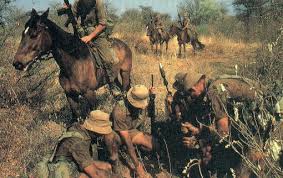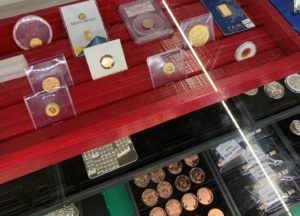In the previous articles: Article 1, Article 2 we provided both an overview of the large use of Tracking during the Colonialism area, and a synopsis of the main techniques of Anti and Counter Tracking employed to defeat the Trackers. We have generally talked about “local guerrillas” and their yearning to gain independence from their Mother Country, often resorting to violent acts, unwearying efforts and frantically developing new strategies.
In the same manner, the Combat Tracking Units organized themselves to overwhelm them. In this article, the final of a series of three, we will examine the most renowned groups: the echo of their ventures have been quoted in several History books as well as in Tracking Manuals.
ì[…] There was a clear evolution in the use of tracking in the counter-insurgency campaigns mounted in white minority dominated Kenya in the 1950s; Rhodesia in the late 1960s and 1970s; and southwest Africa from the late 1960s to 1980s […]î (Professor Timothy J. Stapleton)
In this article, we will discover more on Koevoet, Flechas and Selous Scouts.
“Crowbar”- “Operation K” – “SWAPOL-COIN”
The starting point happens to be one of the rules of the art of reading and following tracks: “Put yourself into the mind of the quarry” (David Scott Donelan, “Tactical Tracking Operations: The Essential Guide for Military and Police Trackers”, 1998). In fact, as seen previously, by knowing your enemy you can anticipate his movement as well as his routes and with that, you can predict his next move.
“When SWAPO infiltration began in the late 1960s the SAP was responsible for counter-insurgency in South West Africa and used trackers from the Bushmen minority and National Parks trackers, and tracker dogs to pursue insurgents. As members of historic hunter-gatherer communities, the Bushmen had a well-known reputation for tracking prowess” (Professor Timothy J. Stapleton).
This Counter Insurgency part of the South West African Police was formed in June 1979 and dismembered after twenty years; it included either white officers from South African Police or Ovamboland volunteers. Their birth was strongly marked by the figures of Selous Scouts.
Their main task was focused on the South African Border War against the insurgents belonging to PLAN (People’s Liberation Army of Namibia). While they originally were involved in intelligence, they soon became successful in leading infiltrations, counting on 3000 people in their workforce.

PLAN insurgents opted to bomb-shelling, in an attempt to defeat the Koevoet Trackers. Among the antitracking techniques adopted, the SWAPO guerrillas tended to increase their speed, creating the so-called ‘time and distance gap’, and often resorting to the use of any vehicles, even sometimes horses, to pursue it.
Since they were perfectly aware of the route of their chasers, they used to set ambushes, employing landmines and IED.
Their patrols could last entire weeks, covering hundreds of kilometers, in search of any suspicious activity. A conviction of murder and rape for an Angolan citizen who served in Koevoet, Jonas Paulus, created a dramatic scandal around the whole group, unveiling controversial facts like atrocities against civilians.
Flechas (Arrows)
They were created by Sub- Inspector Oscar Cardoso as a branch of the PIDE, the Portuguese Secret Police; they remained active from 1967 to 1975 all over the two colonies of Portuguese Angola and Portuguese Mozambique. They mainly consisted of platoons of 30 trackers from local tribes (mostly Khoisan) whose expertise was patrolling, tracking and detecting any Counter insurgency activity especially in a specific area: the so-called “Terras do Fim do Mundo” (Lands of the End of the World), corresponding to the remote part of eastern Angola.

“[…] Cardoso’s concept of the Flechas was to oppose the insurgents with a force of men who were comfortable with the wild and could live off the land [Ö] PIDE found that it helped to give detailed instructions to the Bushmen so they knew what was important in order to reduce vagueness and increase specificity […]”. John Cann, “The Flechas: Insurgent Hunting in Eastern Angola, 1965 1974”
During the years, Flechas gained the respect of the Portuguese Army and they started conducting several operations in a joint effort.
Equally for the Koevoet, Flechas was known for the “brutality and summary executions” (Michael Radu (29 September 2017) “The New Insurgencies: Anti-communist Guerrillas in the Third World”)
After 1975, some individuals formed the RENAMO (Mozambican National Resistance), others were enrolled in the Selous Scouts.
Selous Scouts
They were named after the British explorer Frederick Selous (1851-1917).
They were formed as Special Forces reg. of the Rhodesian Army in 1973 and they remained active till the reestablishment of Zimbabwe in 1980. Mainly employed during the Rhodesin Bush War (a civil conflict that saw the Rhodesian White minority Government led by Ian Smith, the Zimbabwe National Liberation Army, and the Zimbabwe People’s Revolutionary Army).
Set by Lieutenant Colonel Ronald Reid-Daly, Selous Scouts consisted of recruits of either African and European descents. Their task developed in the insurgent-controlled territory. Irregular warfare is what they were not only to detect but to face and even predict. Gathering intelligence was of primary importance as well. At the end of the war, the unit achieved massive success, with 68% of all guerrilla deaths. Their extreme training focused on survival techniques as well as Tracking. This turned them into outstanding professionals.

Reid-Daly said: “a special force soldier has to be a certain very special type of man. In his profile, it is necessary to look for intelligence, fortitude and guts potential, loyalty, dedication, a deep sense of professionalism, or maturity, the ideal age being 24 to 32 years of responsibility and self-discipline… The person that the Scouts were looking for was a mix between the soldier who can work in a unit and a loner who can think and act on his feet”
The Selous Scouts went down in history for the exceptional Tracking Skills and their endurance, as well as for their abilities in camouflage and concealment, fighting the enemy on his own terrain, and with his same weapons.











